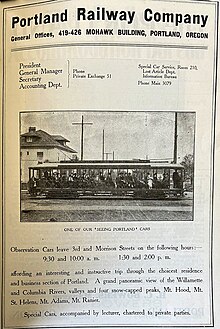|
Portland Railway, Light and Power Company
The Portland Railway, Light and Power Company (PRL&P) was a railway company and electric power utility in Portland, Oregon, United States, from 1906 until 1924.[2] History   A series of mergers of various transportation companies in 1905–1906[3] culminating in the merger of the Portland Street Railway Company; Oregon Water, Power and Railway Company; and the Portland General Electric Company on June 28, 1906, established the Portland Railway, Light and Power Company (PRL&P).[2] Nearly 200 miles of track and 375 urban and interurban streetcars were thereupon consolidated under a single company.[2] Upon its formation, PRL&P became the only company to operate streetcars within Portland city limits; it also continued to sell electric power.[4] The name, Portland General Electric (PGE), remained in use as a division of PRL&P and, after subsequent reorganizations in 1930 and 1940[3] eventually PGE became once again fully independent as a power utility company, making PGE in some ways both an ancestor and a descendant of PRL&P. The company's interurban lines used standard-gauge track, with the exception of the line to Vancouver, Washington, while most of its urban (or "city") lines were narrow-gauge, specifically 3 ft 6 in (1067 mm) gauge.[3] A few lines in the southeast part of the city were standard-gauge,[5] converted from narrow gauge in December 1908 for efficiency, so that they could operate out of PRL&P's Sellwood carbarn, which was closer to the area those lines served but was only equipped for standard-gauge operation.[3]: 129–130 By 1910, PRL&P was a $15 million holding company, having received 43 franchises from the city of Portland, mostly in the form of land grants.[6] It was a monopoly, and "liable to anti-trust action under the Sherman Act."[6][7] The company only installed safety devices (such as pedestrian bumpers) on its streetcars after "extreme public pressure."[6] While PRL&P installed many public streetlights, the city council complained about the power rates charged to the city.[6] PRL&P's president, Franklin Griffith, was part of the corruption and graft surrounding Mayor George Luis Baker; Griffith and others paid off Baker's mortgage.[1]  PRL&P was reorganized as the Portland Electric Power Company (PEPCO) on April 26, 1924.[2] Two former PRL&P streetcar buildings are listed on the National Register of Historic Places. Bay E of the West Ankeny Carbarns was listed in 1978,[8] and the Sellwood Division Carbarn Office and Clubhouse was listed in 2002.[9] The company's 1911 hydroelectric facility in Estacada, Oregon, the River Mill Hydroelectric Project, is also listed on the NRHP.[10] See alsoReferences
Further reading
External links
|
||||||||||||||||
